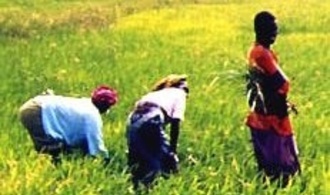Mechanical control : to know more about weeding methods
Written by Modified on the
Manual weeding
In tropical zone, the most widespread control method against weeds remains manual weeding. Technically simple, this operation must however respect several constraints :
Cultivation constraints
- when done too late, weeds have already had a strong competition with the crop;
- if the soil is wet at weeding time, several species, like Commelina benghalensis, do not dry out and succeed in growing back ;
- the re-growth of weeds not properly buried during ploughing, like Digitaria horizontalis, must be weeded in the very first week after sowing, while the normal delay is of three weeks ;
- manual weeding is sometimes delicate when the weed species can be mistaken with the crop, like Oryza barthii, in irrigated rice.
Workforce constraints :
- manual weeding needs between 10 and 20 days of work per hectare, following the standards obtained in dryland row crops ;
- manual weeding is a very tedious activity ;
- family or hired labour, workers are not always available ;
- when crops have been established, over usually a period of one month, there is a competition in the preparation of the work calendar between the crops to be sowed last and the weeding to be done in those first sowed.
The calendar
The critical period of harmfulness is generally situated
- between 15 and 60 days after sowing for short cycle annual crops (cotton, maize, sorghum, etc.)
- between 30 and 90 days after planting for long cycle crops (yam, manioc, sugar cane, etc.).
It is estimated that, currently, the harmfulness of early established weeds represent approximately 30% of losses, in cotton as well as food crops. Thanks to precocious weeding, the crops avoid the weeds’ harmful effects since these can have a competition effect at a young stage. Besides, the task is less difficult since vegetation is less developed and it is more efficient since it avoids the propagation by cuttings of some species, like Commelina benghalensis, or the sowing once more of stumps. Furthermore, it prevents short cycle species like Digitaria horizontalis or Dactyloctenium aegyptium, to produce seeds and thus increase the seed stock.
Mechanical weeding
For crops with wide inter-rows (cotton, maize, sorghum, millet, manioc, sugar cane, etc…), mechanical weeding has the following advantages :
- time saving : the mechanical operation between the rows takes five to ten times less than manual weeding, even if a complementary weeding on the rows is necessary at the beginning of the crop;
- reduction of the tedious work : in mounted cultivation, the steering o a tractor-drawn hoe is a less difficult task than manual weeding;
- absence of inputs : apart from the investment cost, mechanical weeding does not imply any financial expenditure since the work is usually done by family labour;
- combination of practices : the ploughing in of fertilizers can be done by an earthing-up which effects simultaneously a mechanical weeding. Toutefois, la pratique du sarclage mécanique impose certaines contraintes.
However, the practice of mechanical weeding implies some constraints :
- the equipment availability: in mounted cultivation, besides keeping animals, the first investment is of course the plough ; the farms are not always equipped with mechanical weeding equipment ; it is therefore necessary to increase the distribution of usable hoes and to guide farmers to the training f animals for weeding
- the earliness of cultural practices : more than for manual weeding, the earliness of cultural practices prevents the competition of weeds, but first of all facilitates the work by avoiding the jamming of the weeding tools by well developed crop plants
- t he modification of cultural practices : mechanical weeding is not possible if land clearing has left several stumps and residues on the plot, if the sowing is done in line or if the interval between the crop rows is planted with associate crops that prevent the movement of the tools.
For mechanised farms, chopping is a current technique for the maintenance of plots
- in orchards (mango trees, citrus fruits, …) to limit the development of natural weediness between crop rows,
- in pasture lands, to cut harmful species.
Return to the page "Weed science : everything about weeds"
